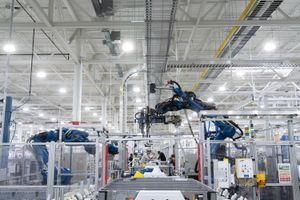Engineers are playing a critical role in the energy transition by dreaming up, developing, and wiring up the billion machines we need to end CO2 emissions. There are endless opportunities to orient your career toward climate solutions, and we were lucky enough to get a taste of what that looks like in practice from Kenton Harris, the Director of Battery Manufacturing Engineering at Rivian.
Kenton is an Illinois-based mechanical engineer and SOW Member who is passionate about making the world a better place. He’s designed drones, hydraulic equipment, and most recently electric vehicles. At Rivian, Kenton leads a team conceptualizing, building, and ramping the Battery Module and Battery Pack manufacturing lines that support the company’s suite of EVs.
Our conversation with Kenton covered the challenges of building an engineering team for an emerging market and the nuts and bolts of the decisions that go into designing EV batteries. The conversation has been condensed and lightly edited.
Stu Sonatina: I'd love to hear about the process of bringing up a manufacturing line for something as complicated as an EV battery. How do you start? Who do you hire? What are some of the big decisions that need to be made early on (software, equipment, location, methods, etc)?
Kenton Harris: The EV battery manufacturing industry is so new that there's not an established pool of experienced engineers, so recruiting is tough. The thing I look for most are people who are comfortable adapting current technology to new applications. As Ted Lasso would say, “Be Curious.”
Big early decisions for us are who our partners are. Cells are expensive, heavy, and dangerous goods, so shipping logistics are intense. We're working on those things with our new Georgia factory right now which is exciting!
Beyond that, we are developing a factory layout while the product is being designed, so you have to be comfortable with ambiguity. Trying to stay flexible as long as possible is important as the fuzzy vision of the future becomes more clear as you get closer to Start of Production.
Monk Eastman: Did you specifically want to get into battery manufacturing? Or did you come into it from somewhere else?
Kenton Harris: I started as a design engineer in defense out of college. I helped build a giant blimp back in 2011, then the program got canceled and it was super... deflating. I wanted to work on something where I got to see the fruits of my labor, not sit on a shelf somewhere. That's what drew me to automotive work. I spent some time building hydraulic valves and really fell in love with process more than product. Figuring out the toughest process and optimizing it to perfection was so cool. Designing equipment that worked 99.999% of the time instead of 99.9% are two totally different architectures. The pursuit of perfection is so motivating to me.
Alex Animashaun: What’s the future of electric energy storage?
Kenton Harris: I'm super excited about LFP batteries for energy storage. Lithium Iron Phosphate is super cheap, has great cycle life, and is much safer than some of the existing chemistries. I think you'll see LFP replace lead acid and high nickel batteries over the next few years.
Their one major downside is they are not very energy dense, so not a great solution for high range requirements. I think you'll see a lot of base model cars use LFP, and halo trims use high nickel.
Hillary Predko: Rivian is introducing LFP batteries in some vehicles. How do you plan and execute such a big change?
Kenton Harris: Yep – we're currently shipping LFP packs in our commercial vans and they are coming to our R1 as our standard range battery. LFP is great for commercial delivery fleets – they don't go very far each day, charge up each night, but travel tons of miles.
The team that launched the LFP Battery did a phenomenal job. The things that hurt you during a launch are rarely the things you expect. I'm a big believer in using a Pre-Mortem as a tool to flesh out failure. Great Freakonomics podcast episode here.
Alex Animashaun: What separates senior engineers from staff/principal engineers other than experience?
Kenton Harris: I'd say the biggest difference is knowing where to dive deep and where you can stick your thumb in the air and give an 80% answer in 2 minutes. Being really good at guesstimating isn't just experience – it's knowing the underlying principles and understanding which direction has fewer downsides.
I think there are 6 key skills of a Manufacturing Engineer. A senior engineer might be super strong in one area but might be lacking in another area. I expect a Sr Staff/Principal Engineer to be 6/5 stars in all aspects and have no weaknesses.
Read the full story
The rest of this post is for paid members only. Sign up now to read the full post — and all of Scope of Work’s other paid posts.
Sign up now


